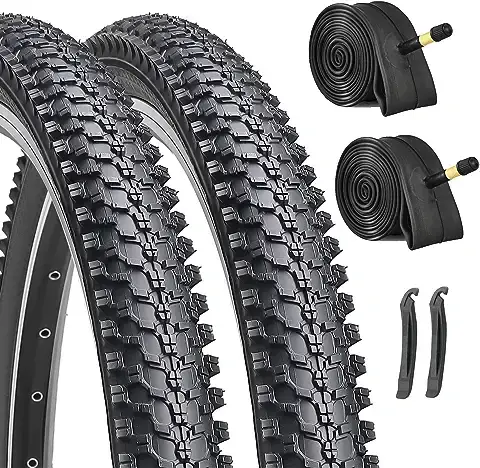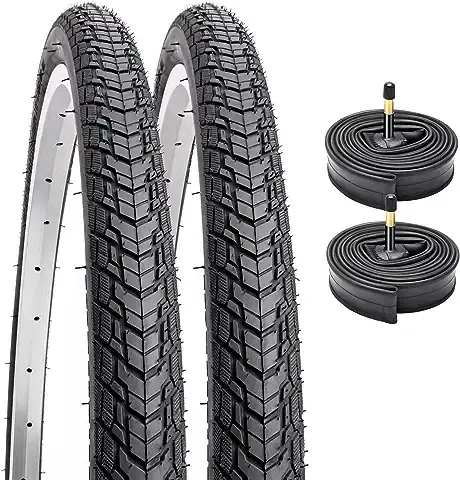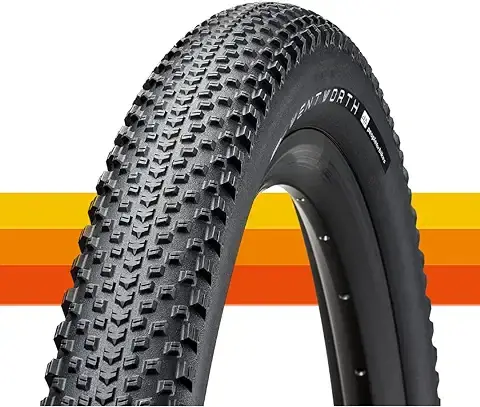Have you ever found yourself puzzled in the bike shop, trying to decipher tire sizes like some cryptic language? You’re not alone. Knowing how to measure a bike tire can feel daunting.
We’ve all been there – standing amid rows of tires that look almost identical, with numbers and letters on them resembling secret codes. 23c, 700x38mm… What does it all mean?
In this guide, we’ll light up your path through the murky world of bike tires. By understanding measurements such as diameter and width or decoding complex systems like ISO measurements and French sizing methods; choosing the right fit for your road bikes or mountain bikes will be like comfortable downhill ride.
Every number tells a tale, predicting your future rides. They hint at the speed you’ll hit and how smooth your journey will be.
Table Of Contents:
- Understanding Bike Tire Measurements
- Step-by-Step Guide to Measuring Your Bike Tires
- Types of Bikes and Their Typical Tire Sizes
- Impact of Tire Pressure on Performance
- Tips for Buying and Maintaining Bike Tires
- FAQs in Relation to How to Measure a Bike Tire
- Conclusion
Understanding Bike Tire Measurements
Bike tires are more than just a rubber ring that hits the road. They’re complex components with specific measurements crucial for optimal performance and safety. You’ve likely noticed numbers printed on your bike tire’s sidewall, but what do they mean?
The two primary measurements you’ll find on any bike tire are diameter and width. Diameter is essentially how big around the tire is, while width refers to how wide it is across its broadest point.
ISO measurements, named after the International Organization for Standardization, provide these dimensions in millimeters (mm). This system aims to reduce confusion by offering consistent sizing globally. So if you see something like ‘700×23’, know this: 700mm is the nominal diameter of the wheel that fits inside such a tire, and 23mm denotes the nominal width of such a type of bicycle tire.
The Importance of Accurate Bike Tire Measurements
Precise measurement matters because it affects not only fit but also ride quality and safety. If your tires don’t match your rims’ size or if they’re too large or small for your frame – riding can become dangerous fast.
An oversized mountain bike tire might rub against your frame causing wear over time or even immediate damage during an intense trail ride. Conversely, fitting a skinny road bike tire onto a wider rim designed for fat bikes may cause unstable handling as there isn’t enough support from side to side.
Different Systems for Measuring Bike Tires
Apart from ISO standards we have another popular way – French sizing method where sizes were originally given in fractional inches; however modern road tyres, mountain bike tyres and many others use decimal sizing.
French tire sizing involves the nominal diameter in mm, followed by a letter code for width: ‘A’ is narrow, ‘D’ is wide. This system isn’t as precise as ISO but you’ll still find it on some tires – especially older or vintage models.
Make sure your next ride packs both performance and safety. Spend some time doing this, alright?
Step-by-Step Guide to Measuring Your Bike Tires
Bike tire measurements are crucial when it comes to replacing your bike tires or upgrading them for better performance. Here, we’ll cover how you can accurately measure your bike tires at home.
Measuring the Outer Diameter
The outer diameter of a tire is essentially its size across the middle from one side to another. To get this measurement, start by placing your tape measure on the ground and line up your wheel with it. Then roll the bike forward until the tire completes one full rotation. The point where it stops gives you an accurate outer diameter.
Measuring Inner Diameter
The inner diameter represents how wide the rim needs to be for a good fit between rim and rubber. Sheldon Brown’s guide suggests that measuring from the bead seat (where the tube sits) in one straight line across the hole center till the bead seat again provides the correct figure.
Measuring Tire Width
Tire width plays a role in ride comfort as well as grip levels on different terrains. For road bikes, narrow tires typically suffice while mountain bikes benefit more from wider ones due to their ability to provide traction over uneven terrain or loose gravel paths. To determine this number: use calipers if available; otherwise, employ a regular ruler aligned parallel against the widest part of the inflated but unmounted tire’s sidewall – do remember to include tread patterns within the calculation.
Determining Nominal Width
Nominal width is generally stated on most modern road and mountain bicycle tires themselves; usually represented as the second part after the “x” sign, e.g., ‘700 x 23’ wherein 23 stands for the nominal value indicating the typical inflated width (in millimeters).
Remember, tire measurements can vary slightly between manufacturers and even individual models. But getting your bike tire sizes right will make a significant difference to your cycling experience.
Measuring Bike Tires Made Easy: When sizing up bike tires, focus on outer and inner diameters along with tire width. Start by rolling your bike for one full wheel rotation to find the outer diameter. Measure from bead seat to bead seat across the rim center for the inner diameter. Lastly, use calipers or a ruler against an inflated tire’s side to accurately gauge its width.
Types of Bikes and Their Typical Tire Sizes
The cycling realm is varied, with various bikes designed to suit different surfaces and riding styles. Let’s explore the typical tire sizes for mountain bikes, road bikes, and gravel bikes.
 Mountain Bike Tires
Mountain Bike Tires
If you’re an off-road adventurer who loves tackling rough trails on your mountain bike, then you’ve probably noticed that these beasts have wider tires than their city counterparts. Mountain bike tires typically come in three non-interchangeable diameters – 29″, 27.5″, or the old-school standard 26″. This variety allows riders to choose a size based on personal preference and trail requirements.
Road Bike Tires
Road warriors might prefer something more streamlined for speedier pursuits. Bike tire sizes are usually narrower than those found on mountain bikes to reduce rolling resistance, allowing them to glide smoothly over asphalt surfaces. The most common road bike tire size is the versatile 700c; however, some touring bicycles use smaller diameter wheels with wider tires for better comfort during long-distance rides.
 Gravel Bike Tires
Gravel Bike Tires
Middle ground anyone? Gravel biking combines elements from both road biking and mountain biking – they can handle both smooth pavement as well as unpaved paths making it quite popular among adventure seekers. They require unique hybrid-style tires which range between narrow road-like designs (around 30mm) up till fat chunky tread patterns similar to mountain bicycle tire models (upwards of about 40mm).
In all cases though, getting the right wheel size directly impacts performance by affecting how your ride handles turns, climbs hills and descends. But remember, wider tires have been proven to be faster and more comfortable for road bikes. This is due to their ability to absorb shocks from bumps on the road, leading to a smoother ride.
every ride more enjoyable. Getting a handle on how tire size affects your bike’s performance can seriously boost your biking game, and make every adventure on two wheels even better.
Impact of Tire Pressure on Performance
Your bike’s tire pressure plays a crucial role in how your ride feels and performs. Having the right tire pressure is essential to getting optimal performance from your bike, not only to avoid flats but also for ideal handling and speed.
The right tire pressure lets you roll quickly, ride smoothly, and avoid flats. Low tire pressure can give more grip, but too low can expose you to punctures, while high tire pressure makes for a rougher ride but is less likely to pinch flat.
Performance Impact
Tire pressures significantly impact performance. Lower pressures allow the tires to deform around bumps for smoother rides. But they also increase rolling resistance because part of the energy goes into deforming the tire instead of forward motion.
A study conducted by Silca showed that reducing inflation pressures resulted in significant reductions in vibration frequency. In other words – lower pressure equals a smoother (and potentially faster) ride.
Handling Effects
Tires are key contact points between bikes and roads/trails. So changes in their condition greatly affect how bikes handle terrain challenges – especially when cornering or braking sharply.
- In wet conditions, slightly lower-than-normal pressures offer better traction as more tread contacts with ground surfaces which helps prevent skidding during sudden stops or turns.
- If under-inflated tires ‘squirm’ under side loads when cornering, over-inflated tires can cause harsh rides as they’re less able to conform to surface irregularities.
- Over-inflation may also decrease grip since a smaller portion of the tire’s tread is in contact with the road or trail. This results in a loss of handling and braking efficiency.
In essence, striking an optimal balance between low enough pressures for comfort and traction, but high enough for efficient rolling and puncture protection requires trial-and-error experiments – especially because appropriate pressures vary significantly depending on rider weight, riding style, weather conditions, and terrain type. So go ahead – give it some thought next time you pump up those bike tires.
Performance & Handling: With lower pressures, you get smoother rides and increased rolling efficiency.
When shopping for bike tires, keep these tips in mind:
- Consider the factors mentioned above, such as riding style, terrain, and tire compatibility with your bike frame.
- Consult tire sizing guides, like Sheldon Brown’s Tire Sizing Guide, to ensure you choose the correct tire width for your bike.
- Read reviews and recommendations from other cyclists to get an idea of the performance and durability of different tire options.
- Visit local bike shops to get expert advice and see the tires in person before making a purchase.
- Compare prices to find the most cost-effective option and search for discounts on the web.
By taking these suggestions into account and considering your particular requirements, you can opt for the right bike tires that will boost your riding experience and ensure your safety while out on the road or track.
Tips for Buying and Maintaining Bike Tires
Buying bike tires is more than just picking a pair that fits. You need to consider factors like the type of riding you do, your bike’s specifications, and the tire’s durability. To ensure you get the best fit for your bike, familiarize yourself with tire labels and specifications.
The first step in buying new tires is understanding tire labels and specifications. These details provide vital information about the size, tread pattern, and performance characteristics of a tire.
One important specification to note when shopping for bike tires is their width measurement. A wider tire offers better grip but may be slower due to increased rolling resistance; whereas narrow tires are lighter and faster but offer less traction.
Another crucial aspect while selecting your ideal road or mountain bike tire involves determining whether it will fit within your bike frame. Remember, not all bikes have space for fat bike tires.
Maintaining Proper Tire Pressure
Beyond purchasing suitable wheels for your ride lies an often overlooked yet essential task – maintaining proper pressure in those spiffy new rubber rings.
Riding with too much or too little air in your tubeless or tubular tires could result in poor handling abilities on common roads as well as off-road terrains; hence adjusting them appropriately enhances both comfortability during rides as well as overall longevity of these pricey purchases.
Prolonging Your Bike Tires’ Lifespan
No matter if we’re talking standard width city cruisers or broad downhill monsters- each bicycle tire requires some love from time-to-time. Simple actions such as regular inspections for wear-and-tear, avoiding over-inflation and ensuring the correct tire fit can extend your bike tires’ lifespan significantly.
For example, mountain bike tires are often subjected to harsher conditions compared to their road counterparts. Therefore, these might require more frequent checks for cuts or tread wear. Additionally, swapping front and rear tires occasionally will ensure even usage – just another hack to squeeze some extra miles out of them.
Finally, don’t forget that storing things correctly is key.
Older bikes from the 1970s may have steel rims with poor braking performance. It’s important to upgrade to modern rims for better safety and braking power.
FAQs in Relation to How to Measure a Bike Tire
How do I know my bike tire size?
Your bike tire size is etched on the sidewall of your tire. It’s typically represented as two numbers – diameter and width.
What does 26-inch mean for bikes?
A 26-inch designation refers to the approximate outer diameter of a bicycle wheel, including its mounted tires.
How do you measure tire size?
To measure a bike tire, check out the number imprinted on its side or manually measure its inner diameter and width using a ruler.
What does 700c mean?
The term ‘700c’ is used in French sizing for road bicycles. It denotes approximately 622mm bead seat diameter which corresponds to about 28 inches.
Conclusion
Measuring bike tires no longer has to be a daunting task. By now, you should know how to measure a bike tire, understand the importance of accurate measurements, and be able to navigate through various global measurement systems.
We’ve taken that journey together from deciphering diameter and width measurements all the way down to selecting suitable tire sizes for different types of bikes like mountain or road bikes. Remember: every number tells a tale about your future rides.
Tire pressure’s impact on performance isn’t something we can overlook either. Adjust it right, and it’ll take your ride from good to great.
The knowledge gained here will help you shop confidently at any bike store – choosing compatible tires with correct tread patterns or even opting for tubeless ones if they fit your style!



